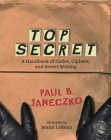Yes, tell me more about about your experiences with book fairs! I'd love to see the list you've developed. With Eleanor in 2nd grade, Isabel in kindergarten, and Will just under 2, I'm going to have plenty of opportunities to be involved with elementary school book fairs for the next -- gulp -- ten years. Tomorrow we volunteer at Isabel's Barnes & Noble fair, for which I've been compiling the teachers' wish lists. I'm loving the glimpses into different classrooms that this affords, and have already started thinking about how to do it more smoothly next year.
 As the holiday season rolls around, I wanted to recommend a book I bought for Eleanor last Christmas, which has turned out to have tremendous staying power:
As the holiday season rolls around, I wanted to recommend a book I bought for Eleanor last Christmas, which has turned out to have tremendous staying power:Top Secret: A Handbook of Codes, Ciphers, and Secret Writing, by Paul B. Janeczko.
It's a fabulous introduction to codemaking, written in clear, accessible prose. Here's the beginning of Chapter 1:
Before we talk about making and breaking codes, we need to realize that most of the time when people talk about making codes and breaking codes, they are not talking about codes at all. They're really talking about ciphers. What's the difference? A code is a system where every word or phrase in your message is replaced by another word, phrase, or series of symbols. On the other hand, a cipher is a system where every letter of your message is replaced by another letter or symbol.
For now, let's stick with codes. For example, you and your partner can make up code words for places in your neighborhood. Your code word for "post office" might be GREEN. Your code word for "playground" might be AWARD.
A code can also be a number. We might say that the code for "post office" is 71715. And the code for "playground" is 71716. Again, the words or numbers don't matter, as long as you and your partner know what they mean.
Janeczko packs the book with examples of codes and ciphers from history, and brief stories about the people who have used them: Thomas Jefferson, Charlemagne, Julius Caesar, The Shadow. He explains the way particular systems have worked, and offers practice codes to encipher and break. The text is broken up with drawings and challenges -- it's easy to dip into and out of. Chapter 2 is all about code breaking, and includes handy frequency lists:
As you know, Jeff is a puzzle-maker and puzzle-solver from way back, so bringing this book into our house was a no-brainer. He and Eleanor solve Ken-Ken puzzles together on the weekend, and I thought this might lead to further father-daughter play. It has.
Eleanor was a little young for Top Secret when I gave it to her last year -- the age range on the back of the book says "9 and up," and that feels pretty accurate to me. She didn't sit right down to read it cover to cover. But when Jeff's birthday came around last August, she pulled out the book and took it to bed with her every night for a week, creating five different enciphered messages for him to crack to reveal the locations of his presents. Last week, Jeff presented Eleanor with an enciphered message, and she used techniques in the book to decipher it. I have a feeling it's going to be in use for a long, long time.
If you don't have a code-breaker parent in the house, you might give a copy to your kid's best friend, and get them started encoding and enciphering messages to each other. Or is this asking for trouble?
I hope your holiday season is getting off to a rousing start. I'd love to hear what you're recommending at the store right now.
Love, Annie

.JPG)
No comments:
Post a Comment